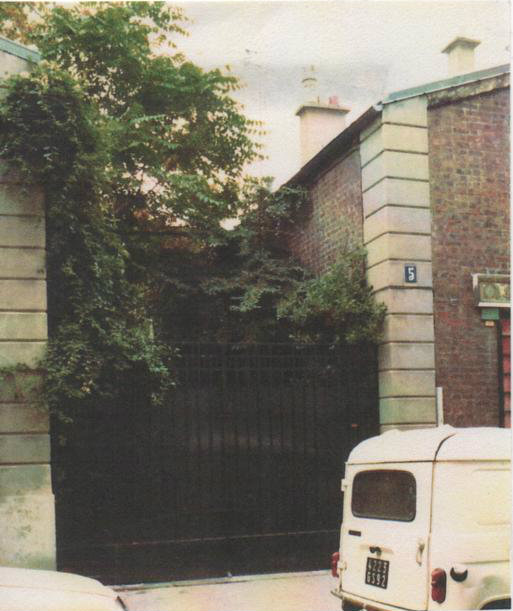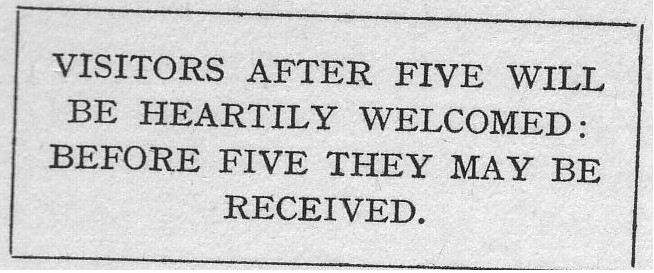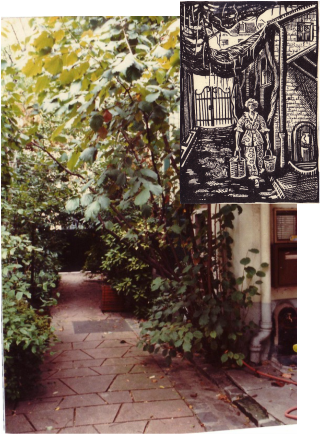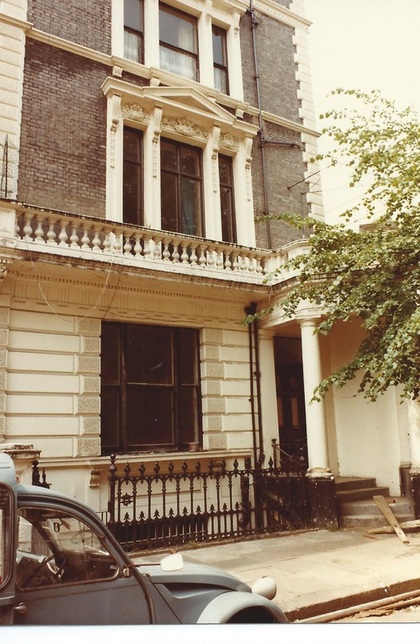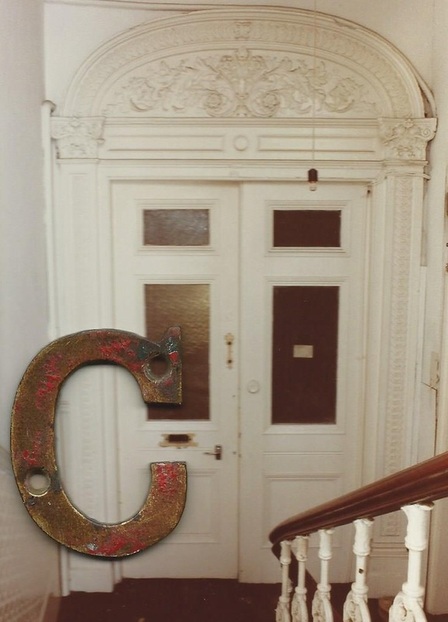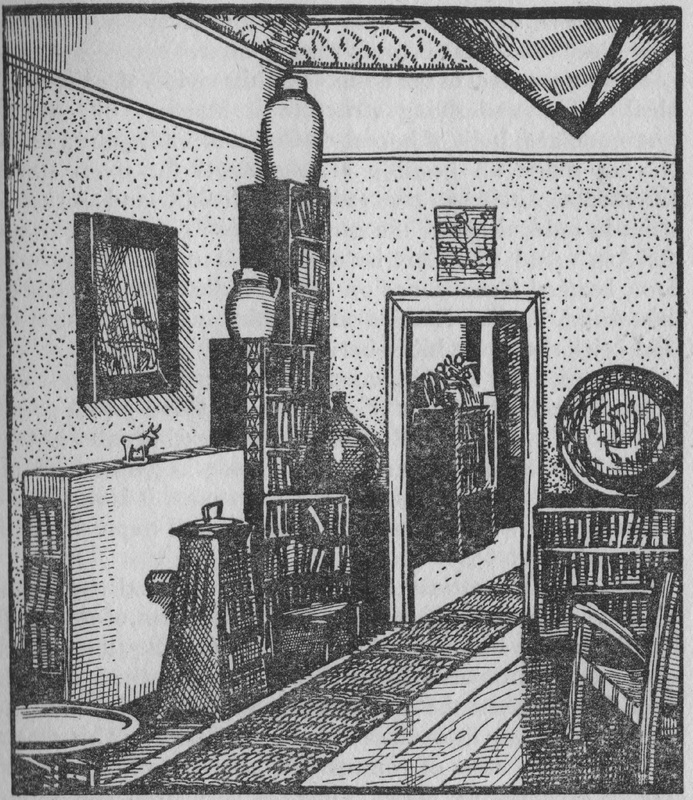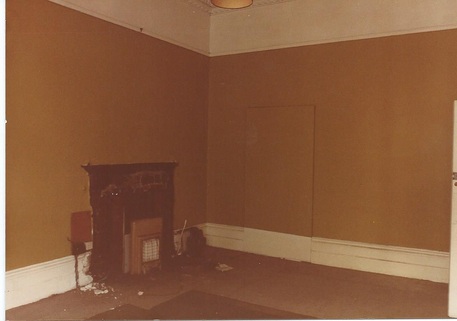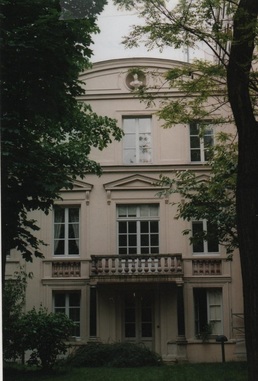
page still under construction
The homes of Jan and Cora Gordon.
Paris 1909 -1932
6 rue Val de Grace and 5 Rue Bagneaux
As part of my obscession with the minutiae of everything to do with the Gordons one thing I have done is to investigate and if possible take a photo of every place they lived in that I could gain access to. After all, their homes feature in several of the Gordons book, notably the Cherche Midi and Clanricarde gardens flats.
Their childhood homes have been shown elsewhere in this site although I never went inside the Buxton or Woodlands ones.
Jan and Cora’s first real home together in Paris after their honeymoon in Wadhurst, Sussex, and in Buxton, Derbyshire was in the building they referred to as the ‘Val de Grace’ studio. This was in reality at 6 Val de Grace, ‘...an old and lovely pavilion...’ once part of the convent of the Val de Grace and rumoured to have been the home of Louise de la Vallière, It is certainly the remains of a very grand house. A more recent inhabitant had been Alphonse Mucha, the artist renowned as the inventor of the Art Nouveau style.
Jan and Cora occupied, at a rent of £36 per annum, five rooms on the top level of a huge ballroom which had been divided horizontally into two apartments. Their main apartment was one huge room some 40ft long by about 7ft high, sparsely furnished with little other than a table, a couple of chairs, Jan’s large yellow Chinese jar and a picture packing case as a model throne. In these sparse surroundings they attempted to augment their meagre savings by starting an etching studio under Jan’s tuition. In this he was so successful that one year all his students were accepted into the Salon, though Jan himself was rejected.1
Another financial project that came to naught was the poster painting scheme. Tempted by the offer of £3-5 per theatre poster design, they tried to research into the flaws of existing poster design. Deciding that the least used colour in these posters was green, they designed a whole series of green posters, only to have them all rejected out of hand. They had failed to include in their research any source of theatrical knowledge and had not found out that in the theatrical world green is considered deadly bad luck.
By around 1912 they had moved to the studios in Rue de Bagneaux2 at the other end of Montparnasse. These studios at No 5 were and still are a haven of peace and quiet just a stone’s throw away from the busy Place de Rennes3 in front of Montparnasse station.
The rue de Bagneaux was a quiet connection between the Rue Cherche-Midi and the Rue Vaugirard; on the north side were three gated alleyways, each with a row of studios converted from what was once stabling for the horses of the Paris Omnibus Company.
Their landlady was a one-time chorus girl in the Paris opera, the mistress of a member of the chamber of deputies from whom she had received the studios as a form of pension. She must have been an astute business woman or simply supportive of the burgeoning artistic community in Paris at the end of the Belle Époque, since she realised the need for cheap studios of a slightly better standard than the most basic, such as existed at La Ruche or the Cité Falguiére on the southern side of Montparnasse.
By 1913 artists of all levels of skill and type inhabited her premises, especially sculptors who found them ideal because of their ground level solid floors and high ceilings,
At the end of the alley Jan and Cora took two studios, opposite each other. Here they certainly appreciated the peace and quiet, shaded under the growths of Clematis and Wisteria; here they ‘…contrived to be content…’. These studios exist in much the same form today, save that Jan and Cora’s studio was destroyed by a shell or bomb in 1943.
Owing to the historic value of the studios they were rebuilt in much the same style but with the frontage set back in order to conform to modern day regulations. The Old Man’s Beard still covers the canopy and shades the alleyway; the communal cabinet that must have so dismayed the more genteel of the Gordons’ visitors still stands in all its glory but these days serves a more mundane but still odorous purpose as a broom and mop cupboard, even the water tap shown in Jan’s sketch of the alley remains, though facilities these days are a good deal more than basic in what are now very chic and sought-after dwellings.
As described by Jan in ‘A Paris Roundabout’ in 1920, the studio (for they had been forced to relinquish one by then for reasons of economy, though they had evidently been able to retain them throughout the war years) was one large room. Parquet floored and ‘…of a form not unlike a huge typewriter box…’ with a gallery to the rear, some seven feet deep and divided into a basic kitchen at one end and at the other a box room and general dump.
There were no toilet facilities save the communal Turkish style ‘cabinets’ across the way. The only water was the previously mentioned single cold water tap in the alley. Heated by a small coal stove and lit by oil lamps it was very basic, but at a rent of £40 per annum it would still have been regarded as luxury by many of the inhabitants of the nearby artist cities in the area. Here Jan and Cora lived contentedly for many years – about twenty according to Jan in ‘London Roundabout’, where he nonetheless retrospectively describes the empty studio they left in 1932 as a ‘sordid hole’!
The furnishings were a little better than at the Val de Grace apartment for they had collected a lot of souvenirs from their travels, and as Jan wrote ‘… a little art covered a great deal of penury…’. Two divans under the galley, covered with colourful Albanian rugs, served as beds. The linen covered walls were hung with old Spanish plates, the stair railings were hung with various musical instruments and, amongst paintings and the huge number of books hung Jan’s engagement portrait of Cora4; underneath that stood a large sycamore chest, bought by Cora for £1 before the war – ‘Inveterate collectors of curios’ they had started early! There was the Breton dough chest bought in the rue Cherche Midi for £1/10/0, Jan’s yellow jar to which he was so attached, and which had followed him from the Malay to Chelsea and to Paris, the large antique earthenware basin from Murcia with the green and yellow cat design, the ancient walnut oil jar, a gift from Mons Tressol in Najac, and innumerable small curios collected on their travels and all displayed on the old Normandy sideboard. Of all these objects now lost only the musical instruments seem to have survived, and then only a partial collection; the remainder languish unloved and uncared for in the bowels of the iceberg that is the storeroom of a South London museum5.
Mostly their neighbours were sculptors6 the ground level studios being ideal for that activity. Although too far away from the main Carrefour Vavin, the hub of Montparnasse, to attract the more illustrious or notorious personalities of that era, or the poverty stricken extremes of the nearby La Ruche studio complex or the rue Vercingétorix, nonetheless the alleyways of numbers 5-7 sheltered for a time their share of celebrated names: Jo Davidson and Moise Kisling in 1912; Diego Rivera in 1920; Otte Skoll in the 1920s; Osip Zadkine was a near neighbour from 1910-1928 and Gertrude Stein was barely 10 minutes walk away on the other side of the boulevard Raspail. The Gordons must have known of the Steins and their collection – they knew Gertrude Stein’s best friend Carl Van Vechten7 and Nina Hamnett was a visitor to the rue de Fleurus; one cannot but wonder if Jan and Cora also had the valued invitation to knock on the door of no 27 de Fleurus for the ritual doorstep challenge of ‘a part de qui vous venez ici?’, from Alice Toklas. It was certainly on their route to the Luxembourg gardens from Cherche Midi. Cora’s attitude to being sidelined in the kitchen with Alice Toklas would have been worth recording.
While the in-crowd of the era preferred to be in staggering distance of the bright lights of Carrefour Vavin and the drinking dens all around, Jan and Cora preferred to work hard at the business of making a living, hence the greeting card pinned to the door of their studio, the last one on the right.
Jan’s much loved ‘Seek-Midday Street’, then a very lively thoroughfare, was full of life and small businesses, proving to be a fruitful source of characters and incidents for Jan’s inventive writer’s mind. An unknown Irish writer in the Dublin Magazine in 1931 caught the essence of the Gordons’ writing exactly. ‘… His eye seeks a ways for the whimsical. The quaint, the naïve, and hails these qualities when he finds them not with malice but with the collector’s pleasure. Like all collectors he finds his treasure in all sorts of unlikely places.’ These sentiments reflect exactly the reasons for which the Gordons’ books about daily life in rural France and Spain are held in such high esteem in those countries today.
‘On a Paris Roundabout’ which was written while in Portugal in 1925, in which he describes the “Restaurant Landru” a tiny and cheap eating house they had discovered in the square off the rue de L’Abbé Grégoire behind their studios is a case in point. Though its true identity is teasingly disguised, as is usual in Jan Gordon’s writing, he uncovers a treasure trove of characters around which he bases the narrative. He describes the book somewhat quaintly as being ‘… the kind of book a beetle might write to recount its journeys while tied to a pin …’, the pin in this case being their studio and the length of string the distance which separated them from the restaurant they named ‘Landru’s’ – in reality a radius of less than 500 yards. Jan claims he avoided exaggeration of any kind, which is entirely believable considering his talent for observing the obscure minutiae of life. In fact the book is an essay in praise of the ‘patronne’ of the restaurant, one Madame Chatelaine. The writer of the review of the book in the Times Literary Supplement of December 15 1927 spotted the fact that this translates as ‘Lady of the Manor’ and went on to praise the book as ‘… one which would be brilliant from the hand of a Frenchman, but as the work of a foreigner it is really extraordinary …’.
What the reviewer did not spot was that this was also a rather complex essay weaving together the far-out yet true tale of the large and aggressive rabbit being kept for the stewpot that had the run of the restaurant and who had killed all the female rabbits in accordance with the timeline of the trial and execution of the French mass murderer Désiré Landru then on trial. The stories run cleverly parallel to each other, with the inevitable Gordon tangents off, in the manner of Tristram Shandy.
1 Stepladder to painting
2 now rue Jean Ferrandi
3now Place Du 14 Juin
4 whereabouts tragically not known, but which was exhibited at one of the salons pre-1914 and was certainly in London at the time of Cora’s death in 1950
5 Horniman reserve collection. Bequeathed to them in October 1950 by Cora’s heir, some of them have gone ‘missing’ while others are in a poor state of preservation;
6
7 Stardust in Hollywood p1
The homes of Jan and Cora Gordon.
Paris 1909 -1932
6 rue Val de Grace and 5 Rue Bagneaux
As part of my obscession with the minutiae of everything to do with the Gordons one thing I have done is to investigate and if possible take a photo of every place they lived in that I could gain access to. After all, their homes feature in several of the Gordons book, notably the Cherche Midi and Clanricarde gardens flats.
Their childhood homes have been shown elsewhere in this site although I never went inside the Buxton or Woodlands ones.
Jan and Cora’s first real home together in Paris after their honeymoon in Wadhurst, Sussex, and in Buxton, Derbyshire was in the building they referred to as the ‘Val de Grace’ studio. This was in reality at 6 Val de Grace, ‘...an old and lovely pavilion...’ once part of the convent of the Val de Grace and rumoured to have been the home of Louise de la Vallière, It is certainly the remains of a very grand house. A more recent inhabitant had been Alphonse Mucha, the artist renowned as the inventor of the Art Nouveau style.
Jan and Cora occupied, at a rent of £36 per annum, five rooms on the top level of a huge ballroom which had been divided horizontally into two apartments. Their main apartment was one huge room some 40ft long by about 7ft high, sparsely furnished with little other than a table, a couple of chairs, Jan’s large yellow Chinese jar and a picture packing case as a model throne. In these sparse surroundings they attempted to augment their meagre savings by starting an etching studio under Jan’s tuition. In this he was so successful that one year all his students were accepted into the Salon, though Jan himself was rejected.1
Another financial project that came to naught was the poster painting scheme. Tempted by the offer of £3-5 per theatre poster design, they tried to research into the flaws of existing poster design. Deciding that the least used colour in these posters was green, they designed a whole series of green posters, only to have them all rejected out of hand. They had failed to include in their research any source of theatrical knowledge and had not found out that in the theatrical world green is considered deadly bad luck.
By around 1912 they had moved to the studios in Rue de Bagneaux2 at the other end of Montparnasse. These studios at No 5 were and still are a haven of peace and quiet just a stone’s throw away from the busy Place de Rennes3 in front of Montparnasse station.
The rue de Bagneaux was a quiet connection between the Rue Cherche-Midi and the Rue Vaugirard; on the north side were three gated alleyways, each with a row of studios converted from what was once stabling for the horses of the Paris Omnibus Company.
Their landlady was a one-time chorus girl in the Paris opera, the mistress of a member of the chamber of deputies from whom she had received the studios as a form of pension. She must have been an astute business woman or simply supportive of the burgeoning artistic community in Paris at the end of the Belle Époque, since she realised the need for cheap studios of a slightly better standard than the most basic, such as existed at La Ruche or the Cité Falguiére on the southern side of Montparnasse.
By 1913 artists of all levels of skill and type inhabited her premises, especially sculptors who found them ideal because of their ground level solid floors and high ceilings,
At the end of the alley Jan and Cora took two studios, opposite each other. Here they certainly appreciated the peace and quiet, shaded under the growths of Clematis and Wisteria; here they ‘…contrived to be content…’. These studios exist in much the same form today, save that Jan and Cora’s studio was destroyed by a shell or bomb in 1943.
Owing to the historic value of the studios they were rebuilt in much the same style but with the frontage set back in order to conform to modern day regulations. The Old Man’s Beard still covers the canopy and shades the alleyway; the communal cabinet that must have so dismayed the more genteel of the Gordons’ visitors still stands in all its glory but these days serves a more mundane but still odorous purpose as a broom and mop cupboard, even the water tap shown in Jan’s sketch of the alley remains, though facilities these days are a good deal more than basic in what are now very chic and sought-after dwellings.
As described by Jan in ‘A Paris Roundabout’ in 1920, the studio (for they had been forced to relinquish one by then for reasons of economy, though they had evidently been able to retain them throughout the war years) was one large room. Parquet floored and ‘…of a form not unlike a huge typewriter box…’ with a gallery to the rear, some seven feet deep and divided into a basic kitchen at one end and at the other a box room and general dump.
There were no toilet facilities save the communal Turkish style ‘cabinets’ across the way. The only water was the previously mentioned single cold water tap in the alley. Heated by a small coal stove and lit by oil lamps it was very basic, but at a rent of £40 per annum it would still have been regarded as luxury by many of the inhabitants of the nearby artist cities in the area. Here Jan and Cora lived contentedly for many years – about twenty according to Jan in ‘London Roundabout’, where he nonetheless retrospectively describes the empty studio they left in 1932 as a ‘sordid hole’!
The furnishings were a little better than at the Val de Grace apartment for they had collected a lot of souvenirs from their travels, and as Jan wrote ‘… a little art covered a great deal of penury…’. Two divans under the galley, covered with colourful Albanian rugs, served as beds. The linen covered walls were hung with old Spanish plates, the stair railings were hung with various musical instruments and, amongst paintings and the huge number of books hung Jan’s engagement portrait of Cora4; underneath that stood a large sycamore chest, bought by Cora for £1 before the war – ‘Inveterate collectors of curios’ they had started early! There was the Breton dough chest bought in the rue Cherche Midi for £1/10/0, Jan’s yellow jar to which he was so attached, and which had followed him from the Malay to Chelsea and to Paris, the large antique earthenware basin from Murcia with the green and yellow cat design, the ancient walnut oil jar, a gift from Mons Tressol in Najac, and innumerable small curios collected on their travels and all displayed on the old Normandy sideboard. Of all these objects now lost only the musical instruments seem to have survived, and then only a partial collection; the remainder languish unloved and uncared for in the bowels of the iceberg that is the storeroom of a South London museum5.
Mostly their neighbours were sculptors6 the ground level studios being ideal for that activity. Although too far away from the main Carrefour Vavin, the hub of Montparnasse, to attract the more illustrious or notorious personalities of that era, or the poverty stricken extremes of the nearby La Ruche studio complex or the rue Vercingétorix, nonetheless the alleyways of numbers 5-7 sheltered for a time their share of celebrated names: Jo Davidson and Moise Kisling in 1912; Diego Rivera in 1920; Otte Skoll in the 1920s; Osip Zadkine was a near neighbour from 1910-1928 and Gertrude Stein was barely 10 minutes walk away on the other side of the boulevard Raspail. The Gordons must have known of the Steins and their collection – they knew Gertrude Stein’s best friend Carl Van Vechten7 and Nina Hamnett was a visitor to the rue de Fleurus; one cannot but wonder if Jan and Cora also had the valued invitation to knock on the door of no 27 de Fleurus for the ritual doorstep challenge of ‘a part de qui vous venez ici?’, from Alice Toklas. It was certainly on their route to the Luxembourg gardens from Cherche Midi. Cora’s attitude to being sidelined in the kitchen with Alice Toklas would have been worth recording.
While the in-crowd of the era preferred to be in staggering distance of the bright lights of Carrefour Vavin and the drinking dens all around, Jan and Cora preferred to work hard at the business of making a living, hence the greeting card pinned to the door of their studio, the last one on the right.
Jan’s much loved ‘Seek-Midday Street’, then a very lively thoroughfare, was full of life and small businesses, proving to be a fruitful source of characters and incidents for Jan’s inventive writer’s mind. An unknown Irish writer in the Dublin Magazine in 1931 caught the essence of the Gordons’ writing exactly. ‘… His eye seeks a ways for the whimsical. The quaint, the naïve, and hails these qualities when he finds them not with malice but with the collector’s pleasure. Like all collectors he finds his treasure in all sorts of unlikely places.’ These sentiments reflect exactly the reasons for which the Gordons’ books about daily life in rural France and Spain are held in such high esteem in those countries today.
‘On a Paris Roundabout’ which was written while in Portugal in 1925, in which he describes the “Restaurant Landru” a tiny and cheap eating house they had discovered in the square off the rue de L’Abbé Grégoire behind their studios is a case in point. Though its true identity is teasingly disguised, as is usual in Jan Gordon’s writing, he uncovers a treasure trove of characters around which he bases the narrative. He describes the book somewhat quaintly as being ‘… the kind of book a beetle might write to recount its journeys while tied to a pin …’, the pin in this case being their studio and the length of string the distance which separated them from the restaurant they named ‘Landru’s’ – in reality a radius of less than 500 yards. Jan claims he avoided exaggeration of any kind, which is entirely believable considering his talent for observing the obscure minutiae of life. In fact the book is an essay in praise of the ‘patronne’ of the restaurant, one Madame Chatelaine. The writer of the review of the book in the Times Literary Supplement of December 15 1927 spotted the fact that this translates as ‘Lady of the Manor’ and went on to praise the book as ‘… one which would be brilliant from the hand of a Frenchman, but as the work of a foreigner it is really extraordinary …’.
What the reviewer did not spot was that this was also a rather complex essay weaving together the far-out yet true tale of the large and aggressive rabbit being kept for the stewpot that had the run of the restaurant and who had killed all the female rabbits in accordance with the timeline of the trial and execution of the French mass murderer Désiré Landru then on trial. The stories run cleverly parallel to each other, with the inevitable Gordon tangents off, in the manner of Tristram Shandy.
1 Stepladder to painting
2 now rue Jean Ferrandi
3now Place Du 14 Juin
4 whereabouts tragically not known, but which was exhibited at one of the salons pre-1914 and was certainly in London at the time of Cora’s death in 1950
5 Horniman reserve collection. Bequeathed to them in October 1950 by Cora’s heir, some of them have gone ‘missing’ while others are in a poor state of preservation;
6
7 Stardust in Hollywood p1
Just off the Rue Cherche is their little hide away studio, at the end of this gated alleyway, despite its 1944 war damage just about exactly the same as they left it in 1932, even the water tap and the very basic outside loos remain, albeit now a broom and mop cupboard
Clanricarde Gardens London, 1932 on; nos 50c and 48d
The first of the Gordons homes I visited was naturally 50c Clanricarde gardens, that being the nearest to me. The house was semi-derelict having been passed from developer to developer, but at last I gained permission to enter and took photos.
Considering this was in 1982 nearly 50 years after Jan and Cora lived there, (they moved to 48d next door in the early 1940s). I was amazed to find the interior almost exactly as they had described it in 'London Roundabout'. Most of the interior fittings had been robbed out so I felt little guilt in apropriating (preservation)the sole portable items left, viz this brass letter C from the door and a broken fireplace tile which now, glued together, serves as somewhere to rest my teacup. Even the red cellulose paint on the C must have been applied by Cora guessing by a line from the book.
The first of the Gordons homes I visited was naturally 50c Clanricarde gardens, that being the nearest to me. The house was semi-derelict having been passed from developer to developer, but at last I gained permission to enter and took photos.
Considering this was in 1982 nearly 50 years after Jan and Cora lived there, (they moved to 48d next door in the early 1940s). I was amazed to find the interior almost exactly as they had described it in 'London Roundabout'. Most of the interior fittings had been robbed out so I felt little guilt in apropriating (preservation)the sole portable items left, viz this brass letter C from the door and a broken fireplace tile which now, glued together, serves as somewhere to rest my teacup. Even the red cellulose paint on the C must have been applied by Cora guessing by a line from the book.
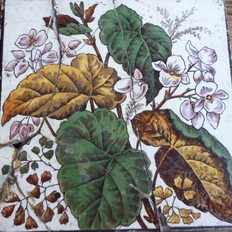 now serving as a teacup stand on my desk this broken tile was salvaged from the wrecked fireplace in the room through the door. This and the door C are the sole remnants of the 50c flat
now serving as a teacup stand on my desk this broken tile was salvaged from the wrecked fireplace in the room through the door. This and the door C are the sole remnants of the 50c flat
This rather un-prepossesing first floor flat was Jan and Cora's home from 1932 until around 1941/2 around which time the houses suffered some small bomb damage. Some time after the start of the war they moved to 48d next door was on the ground floor once occupied by the Buchanans, friends of the Gordons. I feel it likely that Jan's failing health may also have been a factor in the move.
Cora lived there in 48d until her death in 1950 and a family member who was at the dispersal of the Gordon estate records that the basement held a huge volume of papers and paintings, a good deal of which was damaged by damp and thus was destroyed. What has been lost is tragic, mostly for myself as their biographer at least.
